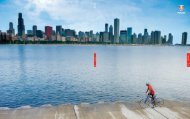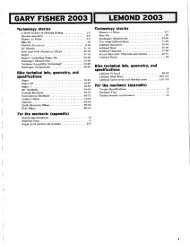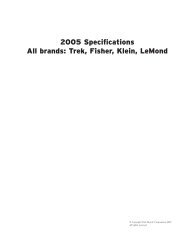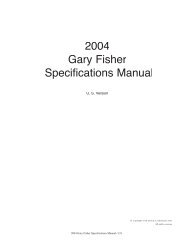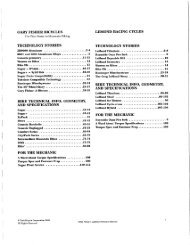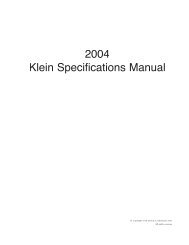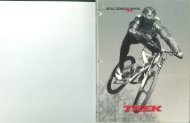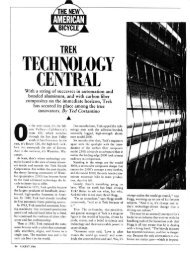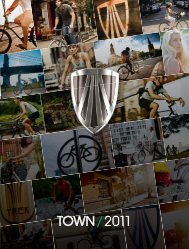TECHNOLOGY STORIES BIKE INFO, GEOMETRY ... - Vintage Trek
TECHNOLOGY STORIES BIKE INFO, GEOMETRY ... - Vintage Trek
TECHNOLOGY STORIES BIKE INFO, GEOMETRY ... - Vintage Trek
Create successful ePaper yourself
Turn your PDF publications into a flip-book with our unique Google optimized e-Paper software.
use a deeper, more aerodynamic rim than the rear wheel.<br />
Mountain bike wheels have different needs<br />
While road bikes benefit from improved aerodynamics,<br />
mountain bikes place a greater need on wheel durability and<br />
rigidity. They also sometimes require special configurations,<br />
like the ability to accept a disc brake rotor. Again, Bontrager<br />
Wheelsystems mountain bike wheels select those features<br />
which will best create the ultimate structure.<br />
With disc-specific wheels, there is no need for a flat<br />
rim sidewall. This allows optimization of the rim shape to<br />
reduce weight. Placing a rotor on the front wheel creates<br />
an asymmetric spoke configuration that benefits from OSB<br />
(Offset Spoke Bed), thereby reducing the required dishing<br />
and providing more balanced spoke tension from left to<br />
right side of the wheel. Disc wheels also used crossed<br />
spokes, to efficiently transfer disc brake forces to the rim.<br />
With rim brakes, Bontrager Wheelsystems incorporate<br />
tall sidewalls so that brake adjustment is easier, and pad<br />
wear has less effect on proper adjustment; taller sidewalls<br />
provide increased surface for the brake pad to mate to.<br />
Like with Bontrager road wheels, Bontrager mountain<br />
wheels focus on balancing spoke tensions on the drive and<br />
non-drive side of the wheel. To do this, they employ OSB<br />
(Offset Spoke Bed) rims and special hub designs with modified<br />
flange spacing. These features greatly reduce the tension<br />
differentials from side to side, creating a stronger,<br />
more durable structure. The higher left side tensions allow<br />
more torque transfer to the left side drive spokes. They also<br />
provide increased strength through reduced lateral wheel<br />
flex. In other words, Bontrager Wheelsystems mountain<br />
wheels are stronger.<br />
Truing Bontrager Wheelsystems wheels<br />
Most Bontrager wheels employ standard, externally<br />
adjustable spoke nipples. The only exceptions are the<br />
Bontrager X-Lite Carbon Road wheels, and the Bontrager<br />
X-Lite Aero road wheels where a small aerodynamic benefit<br />
can make the difference between winning and losing a race.<br />
Bontrager Road wheels use PST (Paired Spoke<br />
Technology) which require a slightly different technique<br />
to true. In many respects, truing Bontrager Wheelsystems<br />
wheels with PST is just like truing a conventionally spoked<br />
wheel. Each spoke has both a vertical and lateral component<br />
to its pulling force. As you tighten a spoke, it pulls<br />
radially in towards the hub, and laterally out towards the<br />
hub flange.<br />
The difference is that on a Bontrager wheel with PST,<br />
the lateral force is directly opposed by its 'partner', the<br />
spoke adjacent to it. As the partner reacts to your tightening<br />
of a spoke, there is no further lateral force applied to the<br />
rim. Contrast that to a conventionally spoked wheel where<br />
each spoke has two 'partners'. As you tighten one spoke,<br />
it effects the tension, and thus the spatial position, of the<br />
two partners. This in turn effects the next outward pair,<br />
and so on.<br />
When truing Bontrager Wheelsystems road wheels, PST<br />
gives you more control over both vertical and lateral rim<br />
deviations. If the rim is slightly out of true but very round,<br />
you can loosen one partner and tighten the other. The rim<br />
moves laterally, but not up or down. And since no other<br />
<strong>Trek</strong> 2002 Tech Manual<br />
spokes are directly affected, you're done.<br />
Vertical deviations<br />
With wheels built in our factory, the tolerance allowed<br />
for vertical deviation is 0.5mm. A 23c tire with 120 PSI will<br />
exhibit more out-of-roundness than this.<br />
Our wheel builders use a vellum, a highly sensitive<br />
truing stand that uses dial indicators driven by wheels<br />
pressing on the rim. When 0.5mm passes by the indicators<br />
on the vellum, the needles move about an inch. What looks<br />
like a mountain on the vellum will be totally missed by<br />
the rider, even at high tire pressures on smooth pavement.<br />
With an egg-shaped wheel where 0.5mm height change<br />
occurs over 1/2 of the wheel rotation, the out-of-roundness<br />
may be invisible with a normal truing stand. If that same<br />
0.5mm deviation occurs in a short rim section, it’s very<br />
visible to the naked eye.<br />
With Bontrager Wheelsystems, the same 0.5mm vertical<br />
tolerance is allowed, but instead of an egg shaped wheel<br />
it can show up over a very short section of the rim. In<br />
either case, the rider will not feel it, nor will it effect the<br />
ride of the bike. Consider the much greater magnitudes<br />
in the out-of-roundness of a wheel. The tire will be out of<br />
round by 1-2mm on a 23c tire, more as the casing gets<br />
bigger. A rider sitting on the bike with that same 23c tire<br />
at 110PSI will compress the tire by another 2-3mm. And<br />
unless your roads are a lot better than here in Wisconsin,<br />
the road surfaces often have 5, 10, and even 20mm variation.<br />
A note about the "little marks" on the rims<br />
On 2002 Bontrager rims there is a small spherical<br />
indentation in the braking surface of the rim. This isn't a<br />
blemish, it's a wear indicator. If the braking surface has<br />
worn so that the indicator is no longer visible, have your<br />
dealer replace the rim.<br />
Technical Specifications<br />
For detailed technical specifications, wheel building<br />
instructions, spoke lengths, tensions, and hub maintenance<br />
information, please refer to the Bontrager Wheel<br />
Building Manual, Bontrager Service Manual, or cybersurf<br />
to www.bontrager.com.<br />
19




